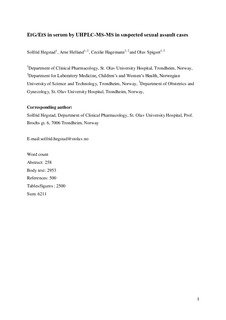| dc.contributor.author | Hegstad, Solfrid | |
| dc.contributor.author | Helland, Arne | |
| dc.contributor.author | Hagemann, Cecilie Therese | |
| dc.contributor.author | Spigset, Olav | |
| dc.date.accessioned | 2018-01-26T09:57:15Z | |
| dc.date.available | 2018-01-26T09:57:15Z | |
| dc.date.created | 2017-06-07T20:35:11Z | |
| dc.date.issued | 2017 | |
| dc.identifier.citation | Journal of Analytical Toxicology. 2017, . | nb_NO |
| dc.identifier.issn | 0146-4760 | |
| dc.identifier.uri | http://hdl.handle.net/11250/2479802 | |
| dc.description.abstract | A method including semi-automated extraction of ethyl glucuronide (EtG) and ethyl sulfate (EtS) from serum followed by ultra-performance liquid chromatography–tandem mass spectrometry (UHPLC–MS-MS) has been developed and validated. Sample preparation prior to UHPLC–MS-MS analysis consisted of protein precipitation and filtration through a phospholipid removal plate. Chromatography was achieved using an HSS T3 column and gradient elution with formic acid in water in combination with methanol. The mass spectrometer was monitored in the negative mode with multiple reaction monitoring. Two transitions were monitored for the analytes and one for the deuterated internal standards (ISs). The limits of quantification were 0.025 mg/L for EtG and 0.009 mg/L for EtS. The between-assay relative standard deviations were in the range of 3.8–9.1%, the recovery was 66–102% and matrix effects ranged from 88 to 97% (corrected with IS). Compared to previously published studies, the method presented is semi-automated, uses a simple method for phospholipid removal and has short run times and low limit of quantifications. We analyzed serum samples from 49 female patients presenting to the Sexual Assault Centre at St. Olav University Hospital in Trondheim, Norway, for ethanol, EtG and EtS. EtG and EtS were detected longer than ethanol itself after intake of ethanol, with estimated maximum detection times of >24 h. The ethanol, EtG and EtS concentrations were highly correlated (P < 0.001), but with large inter-individual variations. This study suggests that analysis of EtG and EtS in serum or blood may complement ethanol analysis and shed light on the patient's recent ethanol intake after ethanol itself is no longer detectable. | nb_NO |
| dc.language.iso | eng | nb_NO |
| dc.publisher | Oxford University Press (OUP) | nb_NO |
| dc.title | EtG/EtS in Serum by UHPLC-MS-MS in Suspected Sexual Assault Cases | nb_NO |
| dc.type | Journal article | nb_NO |
| dc.type | Peer reviewed | nb_NO |
| dc.description.version | acceptedVersion | nb_NO |
| dc.source.pagenumber | 5 | nb_NO |
| dc.source.volume | 41 | nb_NO |
| dc.source.journal | Journal of Analytical Toxicology | nb_NO |
| dc.source.issue | 7 | nb_NO |
| dc.identifier.doi | 10.1093/jat/bkx032 | |
| dc.identifier.cristin | 1474617 | |
| dc.description.localcode | This is a pre-copyedited, author-produced version of an article accepted for publication in [Journal of Analytical Toxicology] following peer review. Locked until 27.4.2018 due to copyright restrictions. The version of record is available online at: https://academic.oup.com/jat/article/41/7/618/3760311 | nb_NO |
| cristin.unitcode | 194,65,15,0 | |
| cristin.unitname | Institutt for klinisk og molekylær medisin | |
| cristin.ispublished | true | |
| cristin.fulltext | postprint | |
| cristin.qualitycode | 1 | |
